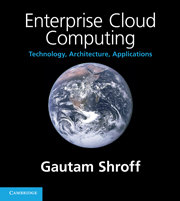Book contents
- Frontmatter
- Contents
- Preface
- List of abbreviations
- Part I Computing platforms
- Part II Cloud platforms
- Part III Cloud technologies
- Chapter 7 Web services, AJAX and mashups
- Chapter 8 Virtualization technology
- Chapter 9 Multi-tenant software
- Part IV Cloud development
- Part V Software architecture
- Part VI Enterprise cloud computing
- References
- Index
Chapter 9 - Multi-tenant software
Published online by Cambridge University Press: 06 December 2010
- Frontmatter
- Contents
- Preface
- List of abbreviations
- Part I Computing platforms
- Part II Cloud platforms
- Part III Cloud technologies
- Chapter 7 Web services, AJAX and mashups
- Chapter 8 Virtualization technology
- Chapter 9 Multi-tenant software
- Part IV Cloud development
- Part V Software architecture
- Part VI Enterprise cloud computing
- References
- Index
Summary
Applications have traditionally been developed for use by a single enterprise; similarly enterprise software products are also developed in a manner as to be independently deployed in the data center of each customer. The data created and accessed by such applications usually belongs to one organization. As we discussed earlier in Chapter 3, hosted SaaS platforms require a single application code to run on data of multiple customers, or ‘tenants’; such behavior is referred to as multi-tenancy. In this chapter we examine different ways to achieve multi-tenancy in application software.
Before proceeding it is important to also note that virtualization, as discussed in the previous chapter, is also a mechanism to achieve multi-tenancy at the system level. In a virtualized environment, each ‘tenant’ could be assigned its own set of virtual machines. Here we examine alternatives for implementing multi-tenancy through application software architecture rather than at the system level using virtual machines. Thus, such multi-tenancy can also be termed application-level virtualization. Multi-tenancy and virtualization are both two sides of the same coin; the aim being to share resources while isolating users from each other: hardware resources in the case of system-level virtualization and software platforms in the case of multi-tenancy.
MULTI-ENTITY SUPPORT
Long before ASPs and SaaS, large globally distributed organizations often needed their applications to support multiple organizational units, or ‘entities,’ in a segregated manner.
- Type
- Chapter
- Information
- Enterprise Cloud ComputingTechnology, Architecture, Applications, pp. 104 - 114Publisher: Cambridge University PressPrint publication year: 2010
- 1
- Cited by



